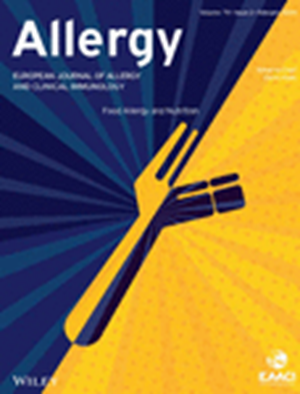成人食物蛋白诱导的小肠结肠炎综合征的严重腹部症状与小肠扩张相关
IF 12
1区 医学
Q1 ALLERGY
引用次数: 0
摘要
食物蛋白诱导的小肠结肠炎综合征(FPIES)是一种非ige介导的食物过敏,可引起胃肠道症状,但其解剖学起源和发病机制尚不清楚。腹胀在成人FPIES中很常见,但患者的症状各不相同。本研究旨在建立评估腹胀的客观标准,并阐明腹胀的病理生理和解剖学起源。方法本研究以26例成人fies患者为研究对象。将腹胀分解为8个因素,并根据阳性率较高的项目制定评价算法。在OFC(口服食物刺激)前后进行临床特征、血液和影像学分析,以探讨病理生理。结果14例成人FPIES患者行OFC, 7例阳性。潜伏期为1.5 h,最常见的症状是腹胀(100%)、腹痛和恶心(71.4%)。所有患者均接受静脉滴注细胞外液和昂丹司琼治疗,缩短了症状持续时间。在对血液检测数据的评估中,除了严重的病例外,没有特异性的fies血清学标志物。计算机断层扫描图像分析显示,在FPIES事件期间,小肠明显扩张和水肿,表明小肠扩张与成人FPIES有关。结论这些结果将有助于在有严重急性胃肠炎症状的成年患者就诊时,根据医学访谈、血液检查数据和影像学表现,及早、适当地诊断fies。本文章由计算机程序翻译,如有差异,请以英文原文为准。
Small Intestinal Dilation Is Associated With Severe Abdominal Symptoms of Food-Protein-Induced Enterocolitis Syndrome in Adults.
BACKGROUND
Food-Protein-Induced Enterocolitis Syndrome (FPIES) is a non-IgE-mediated food allergy that causes gastrointestinal symptoms, though its anatomical origin and pathogenesis remain unclear. Abdominal distention is common in adult FPIES, but symptoms vary among patients. This study aimed to establish objective criteria for assessing abdominal distention and to clarify the pathophysiology and anatomical origin of FPIES.
METHODS
This study targeted 26 adult FPIES patients. Abdominal distention was broken down into eight factors, and an evaluation algorithm was developed based on items with high positivity rates. Clinical characteristics, blood, and imaging analyses were performed before and after OFC (oral food challenge) to investigate the pathophysiology.
RESULTS
Among 14 adult FPIES patients who underwent OFC, seven showed positive results. The latency period was 1.5 h, with the most frequent symptoms being abdominal distention (100%), abdominal pain, and nausea (71.4%). All patients received treatment with intravenous extracellular fluid infusion and ondansetron, which resulted in reduced symptom duration. In an evaluation of blood test data, there were no specific serological markers of FPIES, except in the severe case. Image analysis with computed tomography revealed significant dilation and edema of the small intestine during the FPIES event, suggesting that dilation of the small intestine is associated with adult FPIES.
CONCLUSION
These results are expected to aid in the early and appropriate diagnosis of FPIES based on medical interviews, blood test data, and imaging findings when adult patients present to medical institutions with severe acute gastroenteritis symptoms.
求助全文
通过发布文献求助,成功后即可免费获取论文全文。
去求助
来源期刊

Allergy
医学-过敏
CiteScore
26.10
自引率
9.70%
发文量
393
审稿时长
2 months
期刊介绍:
Allergy is an international and multidisciplinary journal that aims to advance, impact, and communicate all aspects of the discipline of Allergy/Immunology. It publishes original articles, reviews, position papers, guidelines, editorials, news and commentaries, letters to the editors, and correspondences. The journal accepts articles based on their scientific merit and quality.
Allergy seeks to maintain contact between basic and clinical Allergy/Immunology and encourages contributions from contributors and readers from all countries. In addition to its publication, Allergy also provides abstracting and indexing information. Some of the databases that include Allergy abstracts are Abstracts on Hygiene & Communicable Disease, Academic Search Alumni Edition, AgBiotech News & Information, AGRICOLA Database, Biological Abstracts, PubMed Dietary Supplement Subset, and Global Health, among others.
 求助内容:
求助内容: 应助结果提醒方式:
应助结果提醒方式:


